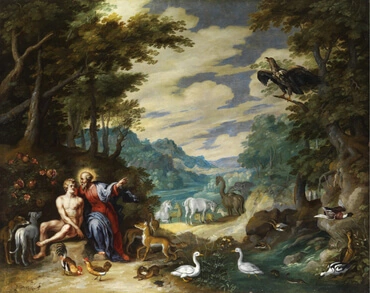1
Und Adam erkannte sein Weib Heva, und sie ward schwanger und gebar den Kain und sprach: Ich habe den Mann, den HERRN.
2
Und sie fuhr fort und gebar Habel, seinen Bruder. Und Habel ward ein Schäfer, Kain aber ward ein Ackermann.
3
Es begab sich aber nach etlichen Tagen, daß Kain dem HERRN Opfer brachte von den Früchten des Feldes,
4
und Habel brachte auch von den Erstlingen seiner Herde und von ihrem Fetten. Und der HERR sah gnädiglich an Habel und seine Opfer;
5
aber Kain und sein Opfer sah er nicht gnädiglich an. Da ergrimmete Kain sehr, und seine Gebärde verstellte sich.
6
Da sprach der HERR zu Kain: Warum ergrimmest du, und warum verstellet sich deine Gebärde?
7
Ist's nicht also? wenn du fromm bist, so bist du angenehm; bist du aber nicht fromm, so ruhet die Sünde vor der Tür. Aber laß du ihr nicht ihren Willen, sondern herrsche über sie.
8
Da redete Kain mit seinem Bruder Habel. Und es begab sich, da sie auf dem Felde waren, erhub sich Kain wider seinen Bruder Habel und schlug ihn tot.
9
Da sprach der HERR zu Kain: Wo ist dein Bruder Habel? Er sprach: Ich weiß nicht; soll ich meines Bruders Hüter sein?
10
Er aber sprach: Was hast du getan? Die Stimme deines Bruders Bluts schreiet zu mir von der Erde.
11
Und nun verflucht seiest du auf der Erde, die ihr Maul hat aufgetan und deines Bruders Blut von deinen Händen empfangen.
12
Wenn du den Acker bauen wirst, soll er dir fort sein Vermögen nicht geben. Unstet und flüchtig sollst du sein auf Erden.
13
Kain aber sprach zu dem HERRN: Meine Sünde ist größer, denn daß sie mir vergeben werden möge.
14
Siehe, du treibest mich heute aus dem Lande und muß mich vor deinem Angesicht verbergen und muß unstet und flüchtig sein auf Erden. So wird mir's gehen, daß mich totschlage, wer mich findet.
15
Aber der HERR sprach zu ihm: Nein, sondern wer Kain totschlägt, das soll siebenfältig gerochen werden. Und der HERR machte ein Zeichen an Kain, daß ihn niemand erschlüge, wer ihn fände.
16
Also ging Kain von dem Angesicht des HERRN und wohnete im Lande Nod, jenseit Eden, gegen Morgen.
17
Und Kain erkannte sein Weib, die ward schwanger und gebar den Hanoch. Und er bauete eine Stadt, die nannte er nach seines Sohnes Namen Hanoch.
18
Hanoch aber zeugete Irad, Irad zeugete Mahujael, Mahujael zeugete Methusael, Methusael zeugete Lamech.
19
Lamech aber nahm zwei Weiber; eine hieß Ada, die andere Zilla.
20
Und Ada gebar Jabal; von dem sind herkommen, die in Hütten wohneten und Vieh zogen.
21
Und sein Bruder hieß Jubal; von dem sind herkommen die Geiger und Pfeifer.
22
Die Zilla aber gebar auch, nämlich dem Thubalkain, den Meister in allerlei Erz und Eisenwerk. Und die Schwester des Thubalkain war Naema.
23
Und Lamech sprach zu seinen Weibern, Ada und Zilla: Ihr Weiber Lamechs, höret meine Rede und merket, was ich sage: Ich habe einen Mann erschlagen mir zur Wunde und einen Jüngling mir zur Beule.
24
Kain soll siebenmal gerochen werden, aber Lamech siebenundsiebenzigmal.
25
Adam erkannte abermal sein Weib, und sie gebar einen Sohn, den hieß sie Seth; denn Gott hat mir, sprach sie, einen andern Samen gesetzt für Habel, den Kain erwürget hat.
26
Und Seth zeugete auch einen Sohn und hieß ihn Enos. Zu derselbigen Zeit fing man an zu predigen von des HERRN Namen.







